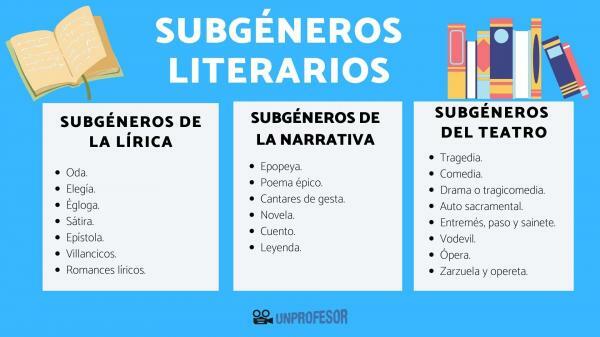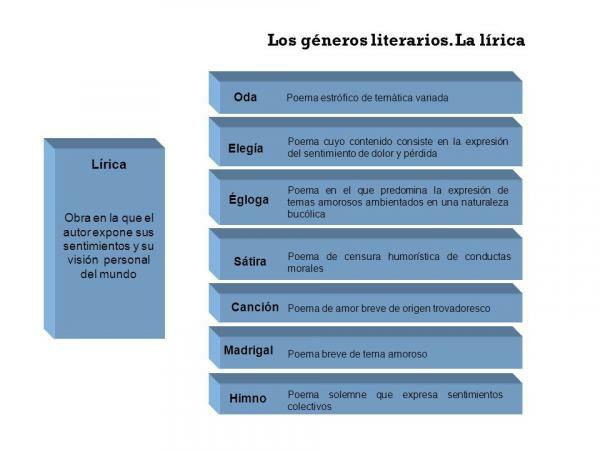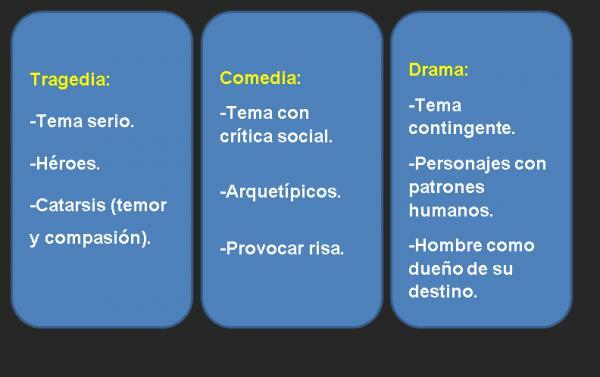Literary subgenres: characteristics and examples

When we talk about literary genres and subgenres we are referring to a series of categories that help us to classify the different literary works that exist, taking into account aspects such as structure or content. In general terms you should know that rhetoric indicates that there are three major literary genres, narrative, lyrical and dramatic, within which there are literary subgenres more specific.
In this lesson from a TEACHER we are going to discover you what are literary subgenres, their characteristics and examples so that you can better know this literary categorization of the texts that are part of our corpus.
Index
- Literary genres and subgenres: definition
- Lyrical subgenres: characteristics and types
- Narrative subgenres: characteristics and different types
- Literary subgenres of theater or drama
Literary genres and subgenres: definition.
In order to fully understand what literary subgenres are, we have to climb one position up and talk about the
literary genres. We are facing different categories that have been created to be able to classify the extensive literary corpus that exists in the sector. As we have already anticipated in the introduction, rhetoric differentiates 3 major literary genres:- Narrative: the action is narrated by an author.
- Lyric: the lyrical subject, poet, is who creates the text.
- Drama: the text will be acted, interpreted, by a group of people. It is the genre that refers to the theater.
What is a literary subgenre?
The classification of the 3 literary genres is still very extensive and, precisely for this reason, the literary subgenres were created, that is, different categories within the mother category (the literary genre). For example, a tragic play is not the same as a comic, right? Well, to better differentiate these types of text, subgenres were created in literature that, now, we are going to know more deeply.

Image: Slideshare
Lyrical subgenres: characteristics and types.
We start with the lyric, since it is one of the most complex and peculiar literary genres. In the lyric, the writer uses the language in a poetic and aesthetic way to offer an idea, a point of view, talk about your feelings, your thoughts, and so on. Therefore, it is a subjective genre and in which the author's "I" has a very special weight.
We must not confuse lyric with poetry because you can write poems with poetic prose and it is also considered lyrical. The lyric is the genre in which the author uses literary devices to emphasize the expressive function of language and get thrill and impress the reader.
To know the lyrical subgenres it is important that we know that there are two currents within the lyric:
- Cultured lyric. It is the one written by a well-known author and that has come to us thanks to the fact that it has been written.
- Popular lyric. It is a lyric that was sung by the people at parties or celebrations. It has come to us orally and they don't usually have a defined author.
Subgenres of cultured lyric
- Ode. It is an extensive composition and it is written in verse. Its origin is in Ancient Greece and these texts used to praise a person or some specific event.
- Elegy. It is another of the literary subgenres within the best known lyric. This composition is written to express the pain produced by the death of a person or by a tragedy.
- Eclogue. We are facing an extensive poem that usually deals with love themes and whose characters are shepherds who are presented as idealized beings. The locus amoenus it was the most common literary topic in this type of composition.
- Satire. Satire is a type of lyrical subgenre that is used to ridicule or criticize people or social groups. The tone is mocking and humorous.
- Epistle. It is a lyrical creation presented in the form of a letter and that usually has a didactic intention.
Lyrical subgenres of popular tradition
- Christmas carols. They are rhythmic compositions that used to be accompanied by music. The themes are very varied and, of course, there are also the Christmases that we continue to sing today.
- Lyrical romances. They are love-themed romances.

Image: Google Sites
Narrative subgenres: characteristics and different types.
We continue to know the different literary subgenres to speak, now, of those belonging to the narrative genre. In this type of text, a narrator is in charge of explaining a story starring specific characters and where there is a main action and a conflict. Therefore, we are facing a genre in which action is of great importance, more than feelings (as is the case with lyric). There are different types of storytellers that the author will be able to choose as he is most interested
As with the lyric, there are some narrative texts written in verse and others in prose. Therefore, we should not confuse prose with narrative because, as we see, this association is not always fulfilled.
Narrative subgenres in verse
- Epic. It is one of the best known and most cultivated literary subgenres in classical and medieval literature. Here the heroic stories of important people in society are told. The Aeneid Virgilio is one of the best known and studied epics.
- epic poem. They are narrative texts of great length and written in verse that focus on explaining the deeds of a hero or knight. The objective of the time is to raise the country.
- Songs of deed. These texts focus on explaining the feats performed by a warrior. They are poems that were composed to be recited orally with the musical company of the minstrels. In Spain, a great example of this literary subgenre is The Song of Mine Cid.
Prose narrative subgenres
- Novel. It is one of the best-known and currently most popular subgenres of narrative. We are facing a fictional story that is usually of medium or long length and where some characters star in a story that has a beginning and an end. The Quijoteis one of the most studied and emblematic Spanish novels of the Golden Age, as well as The Lazarillo de Tormes.
- Story. It is a type of literary subgenre similar to the novel, but with the peculiarity that it is much shorter. There are popular tales or cultured or literary tales, depending on whether their origin was oral or written.
- Legend. The legend is a story that focuses on talking about a character or event that is legendary. It is of oral tradition and the story is based on reality, although it incorporates elements of fiction.

Literary subgenres of theater or drama.
We finish this review of the characteristics of the literary subgenres to speak, now, of those that are part of the dramatic genre, that is, the theater. This genre is characterized by being written to be represented, therefore, it is a text in which dialogues abound and where the action also has a very important point.
The origin of the theater takes place in Ancient Greece, civilization that coined the basic subgenres of drama and that are known as "majors"; although, currently, there are also minor subgenres. Here we tell you!
Major dramatic subgenres
- Tragedy. It is a theatrical text in which the protagonist has an adverse destiny and is moved by very passionate feelings such as hatred, love, greed, revenge, etc. The most outstanding characteristic is that the tragedy always has a tragic ending, that is, the protagonist will end badly.
- Comedy. Comedy is the antithesis of tragedy. Its objective was to entertain the public with texts starring funny characters and with a surprising plot. The tone is satirical and always launches a complaint or criticism of society.
- Drama or tragicomedy. Drama is the mixture of tragedy and comedy, therefore, it is tragicomedy. Here we find the existence of a deep and painful conflict, but the subgenre allows comic elements and funny situations.
Minor theatrical subgenres
- Auto sacramental. We are facing a dramatic text with a religious theme and of short length. It used to be allegorical and is a type of theater typical of the Middle Ages.
- Entremés, step and sainete. They were the theatrical resources that the authors had to liven up the changes of act in comedies or major theatrical works. The most famous are the Cervantes hors d'oeuvres, funny and satirical texts that wanted to entertain the public.
- Vaudeville. It is a theatrical subgenre that emerged in 19th century France and whose main theme is infidelity in a couple. A very colorful, fun type of text with constant surprises.
Lyrical or musical theater
- Opera. We are facing one of the best known literary subgenres within the theater. The opera mixes classical music and texts sung by artists with very powerful voices.
- Zarzuela and operetta. Music is combined with dialogue and has a more cheerful and traditional tone. The Operetta It is the typical Spanish genre that became very popular in the 19th century.

Image: Google Sites
If you want to read more articles similar to Literary subgenres: characteristics and examples, we recommend that you enter our category of Literary concepts.
Bibliography
- Marchese, A., & Forradellas, J. (1986). Dictionary of rhetoric, criticism and literary terminology. Ariel.
- Neveleff, J. (1997). Classification of literary genres. Noveduc Books.
- THE GENRES, Y. S. L. (1976). CHAPTER II THE GENRES AND LITERARY SUBGENERES. Universal literature through select authors, 7.



